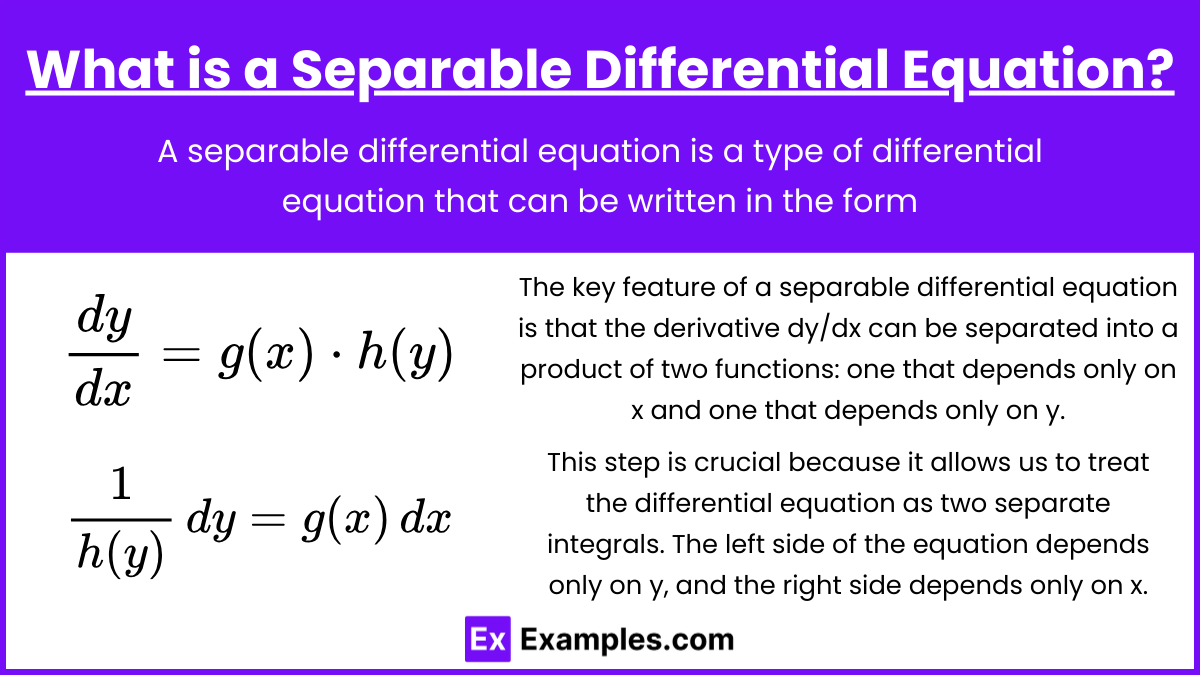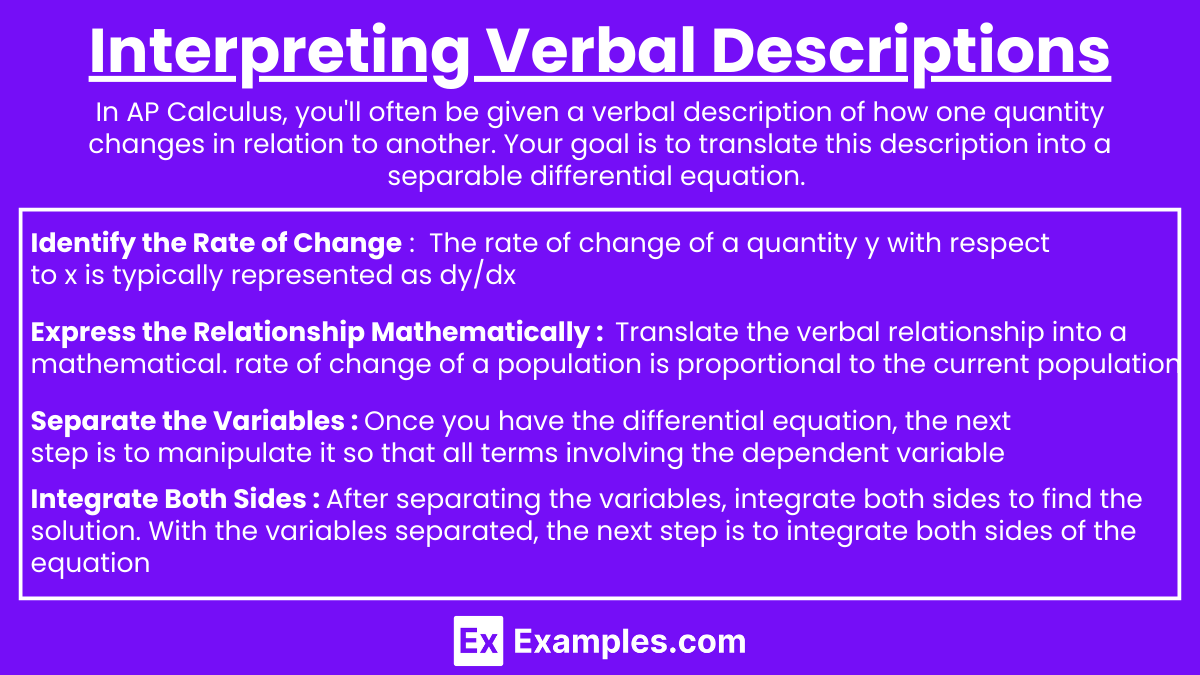In both AP Calculus AB and BC, students often encounter problems where they must interpret verbal descriptions of how a quantity changes over time or space and express these changes mathematically using differential equations. One common approach is to translate these descriptions into separable differential equations, which can be solved by separating the variables and integrating both sides. Mastering this skill is crucial, as it allows students to model and solve real-world problems involving rates of change, such as population growth, cooling processes, and motion.
Free AP Calculus AB Practice Test
Free AP Calculus BC Practice Test
Learning Objectives
When studying "Interpreting verbal descriptions of change as separable differential equations" for the AP Calculus AB and BC exams, you should focus on key learning objectives. These include recognizing and translating real-world scenarios into differential equations, identifying when a differential equation is separable, and mastering the technique of separating variables for integration. Additionally, you should learn to interpret the solutions of these equations in the context of the problem, applying them to various situations such as exponential growth, decay, and mixing problems
What is a Separable Differential Equation?

A separable differential equation is a type of differential equation that can be written in the form:
The key feature of a separable differential equation is that the derivative dy/dx can be separated into a product of two functions: one that depends only on x and one that depends only on y. This allows us to "separate" the variables by placing all terms involving y on one side of the equation and all terms involving x on the other side.
This can be rearranged to separate the variables x and y on opposite sides of the equation:
This step is crucial because it allows us to treat the differential equation as two separate integrals. The left side of the equation depends only on y, and the right side depends only on x.
Interpreting Verbal Descriptions

In AP Calculus, you'll often be given a verbal description of how one quantity changes in relation to another. Your goal is to translate this description into a separable differential equation.
Here’s how to approach it:
1. Identify the Rate of Change
The rate of change of a quantity y with respect to x is typically represented as dy/dx.
"Proportional to": Indicates that the rate of change is directly proportional to a particular quantity. Mathematically, this means multiplying the quantity by a constant.
"Varies with": Suggests a direct relationship between two quantities, often leading to a proportional relationship.
"Inversely proportional to": Indicates that the rate of change is inversely related to a quantity, meaning it’s proportional to the reciprocal of that quantity.
2. Express the Relationship Mathematically
Translate the verbal relationship into a mathematical one. For example:
"The rate of change of a population is proportional to the current population" becomes: dtdP=kP
"The rate of cooling of an object is proportional to the difference between its temperature and the ambient temperature" becomes: (\frac{dT}{dt} = -k(T - T_{\text{ambient}}$
3. Separate the Variables
Once you have the differential equation, the next step is to manipulate it so that all terms involving the dependent variable (e.g., y or P) are on one side of the equation, and all terms involving the independent variable (e.g., x or t) are on the other side.
4. Integrate Both Sides
After separating the variables, integrate both sides to find the solution.
With the variables separated, the next step is to integrate both sides of the equation to find the general solution.
Examples
Example 1. Bacterial Growth
Verbal Description: The rate of growth of a bacterial population P(t) at any time t is directly proportional to the current population size. Mathematical Translation: This implies that as the population increases, the rate at which it grows also increases. The differential equation can be expressed as , where k is the constant of proportionality. Separating the variables gives , and integrating both sides leads to , which simplifies to after exponentiating both sides.
Example 2. Radioactive Decay
Verbal Description: The rate at which a radioactive substance decays is proportional to the amount of the substance remaining at time t. Mathematical Translation: Since the substance decays over time, the rate of change of the substance A(t) is negative, indicating a decrease. The differential equation is given by , where k is a positive constant. Separating the variables gives , and integrating both sides results in , which can be rewritten as .
Example 3. Mixing Problem in a Tank
Verbal Description: A tank contains a mixture of salt and water, and pure water flows into the tank at a constant rate while the mixture is drained at the same rate. The rate of change of the amount of salt S(t) in the tank is proportional to the concentration of salt in the tank at any time t. Mathematical Translation: The differential equation modeling this situation is , where r is the flow rate and V is the volume of the solution. Separating the variables gives . Integrating both sides results in , which can be rewritten as .
Example 4. Newton's Law of Cooling
Verbal Description: The rate at which an object cools is proportional to the difference between its temperature T(t) and the surrounding ambient temperature Tambient. Mathematical Translation: The differential equation is expressed as , where k is a positive constant. Separating the variables gives . After integrating both sides, the solution is , which simplifies to .
Example 5. Logistic Population Growth
Verbal Description: The rate of change of a population P(t) is proportional to both the current population size and the difference between the population and the carrying capacity K of the environment. Mathematical Translation: This situation leads to the logistic growth model, expressed as . Separating the variables involves some algebra: . This equation can be solved by partial fractions and then integrated to find the population function P(t) over time. The solution involves logarithmic functions and describes how the population approaches the carrying capacity K over time.
Multiple Choice Questions
Question 1
Which of the following differential equations is separable?
A)
B)
C)
D)
Correct Answer: B
Explanation: The equation is separable because it can be written as , allowing the variables y and x to be separated on opposite sides of the equation.
Question 2
A population of bacteria grows at a rate proportional to its current size. Which of the following differential equations represents this situation?
A)
B)
C)
D)
Correct Answer: B
Explanation: The phrase "grows at a rate proportional to its current size" indicates that the rate of change of the population P is proportional to P itself, which is represented by the equation , where k is a constant.
Question 3
Given the separable differential equation $ \frac{dy}{dx} = 3y \), what is the general solution?
A)
B)
C)
D) \D) ( y = 3x^2 + C $
Correct Answer: B
Explanation: To solve the equation, separate the variables: . Integrating both sides gives . Exponentiating both sides results in , where C is the constant of integration.


